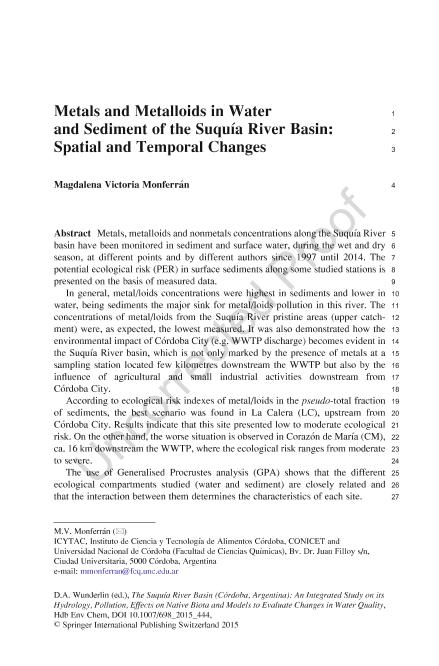Artículo
Metals and metalloids in water and sediment of the Suquía River basin: Spatial and temporal changes
Fecha de publicación:
10/2015
Editorial:
Springer Verlag
Revista:
Handbook of Environmental Chemistry
ISSN:
1867-979X
Idioma:
Inglés
Tipo de recurso:
Artículo publicado
Clasificación temática:
Resumen
Metals, metalloids and nonmetals concentrations along the Suquía River basin have been monitored in sediment and surface water, during the wet and dry season, at different points and by different authors since 1997 until 2014. The potential ecological risk (PER) in surface sediments along some studied stations is presented on the basis of measured data. In general, metal/loids concentrations were highest in sediments and lower in water, being sediments the major sink for metal/loids pollution in this river. The concentrations of metal/loids from the Suquía River pristine areas (upper catchment) were, as expected, the lowest measured. It was also demonstrated how the environmental impact of Córdoba City (e.g. WWTP discharge) becomes evident in the Suquía River basin, which is not only marked by the presence of metals at a sampling station located few kilometres downstream the WWTP but also by the influence of agricultural and small industrial activities downstream from Córdoba City. According to ecological risk indexes of metal/loids in the pseudo-total fraction of sediments, the best scenario was found in La Calera (LC), upstream from Córdoba City. Results indicate that this site presented low to moderate ecological risk. On the other hand, the worse situation is observed in Corazón de María (CM), ca. 16Â km downstream the WWTP, where the ecological risk ranges from moderate to severe. The use of Generalised Procrustes analysis (GPA) shows that the different ecological compartments studied (water and sediment) are closely related and that the interaction between them determines the characteristics of each site.
Palabras clave:
Metalloids
,
Metals
,
Sediment
,
Suquía River Basin
,
Water
Archivos asociados
Licencia
Identificadores
Colecciones
Articulos(ICYTAC)
Articulos de INST. DE CIENCIA Y TECNOLOGIA DE ALIMENTOS CORDOBA
Articulos de INST. DE CIENCIA Y TECNOLOGIA DE ALIMENTOS CORDOBA
Citación
Monferran, Magdalena Victoria; Metals and metalloids in water and sediment of the Suquía River basin: Spatial and temporal changes; Springer Verlag; Handbook of Environmental Chemistry; 62; 10-2015; 113-143
Compartir
Altmétricas




